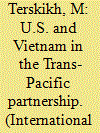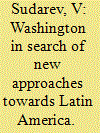|
|
|
Sort Order |
|
|
|
Items / Page
|
|
|
|
|
|
|
| Srl | Item |
| 1 |
ID:
173300


|
|
|
|
|
| Summary/Abstract |
TWELVE COUNTRIES. Roughly 40% of global GDP. One-third of world trade. More than five years of talks, 30 topics of negotiation and 6,000 pages of text. All of this went into the Trans-Pacific Partnership Treaty, a free trade agreement (FTA) that was one of the world's most ambitious economic projects but never came into force. It was an accord of a new type that stated a new perception of trade, was to be a major step in its liberalization, and reflected all key international trends from e-commerce to gender equality.
|
|
|
|
|
|
|
|
|
|
|
|
|
|
|
|
| 2 |
ID:
152584


|
|
|
|
|
| Summary/Abstract |
In his inaugural address, U.S. President Donald Trump pledged that economic nationalism would be the hallmark of his trade policy. “We must protect our borders from the ravages of other countries making our products, stealing our companies, and destroying our jobs,” he said. Within days, he withdrew the United States from the Trans-Pacific Partnership (TPP), announced that he would renegotiate the North American Free Trade Agreement (NAFTA), and threatened to impose a special tax on U.S. companies that move their factories abroad.
|
|
|
|
|
|
|
|
|
|
|
|
|
|
|
|
| 3 |
ID:
151064


|
|
|
|
|
| Summary/Abstract |
Sitting strategically astride one of the busiest and most critical shipping lanes of the world, there is no place better than Galle in Sri Lanka, to brainstorm about the Oceans. There was a time when oceans were deemed barriers between land masses. That paradigm has shifted to view oceans as connectors of land masses. This has been made possible by maritime transportation offering economies of scale that far surpasses what is possible on continent; an edge that has only grown with passage of time.
|
|
|
|
|
|
|
|
|
|
|
|
|
|
|
|
| 4 |
ID:
155096


|
|
|
|
|
| Summary/Abstract |
Of the recent transformations in the political economy of the Asia-Pacific, one of the most dramatic has been to the region's trade architecture. For many years, Asian government were committed trade multilateralists: pursuing liberalisation either globally through the GATT, or regionally via APEC's model of open regionalism. Underpinned by US and Japanese leadership, this system provided the foundation for the export-driven Asian economic miracle. But since the early twenty-first century, the system has been rapidly transformed. The proliferation of preferential trade agreements has threatened to undermine the cohesiveness of regional trade arrangements. The emergence of WTO-Plus style liberalisation, emphasising services, investment and intellectual property, marks the maturation of a system previously focussed on tariff reduction and manufacturing exports. Since 2011, competition between two ‘mega-regional’ proposals – the Trans-Pacific Partnership and the Regional Comprehensive Economic Partnership – is also indicative of new splits which cut across traditional developmental divides. Growing geopolitical rivalry between the US and China has also raised question of who will lead the next round of liberalisation in the region. Exploring these new trends, this paper argues the trade architecture of the Asia-Pacific is entering is becoming more contested and fragmented, with major implications for economic regionalism in coming years.
|
|
|
|
|
|
|
|
|
|
|
|
|
|
|
|
| 5 |
ID:
146276


|
|
|
|
|
| Summary/Abstract |
THE TRANS-PACIFIC PARTNERSHIP (TPP) agreement* was signed in October 2015 by 12 member countries of Asia-Pacific Economic Cooperation (APEC) - Australia, Brunei, Canada, Chile, Japan, Malaysia, Mexico, New Zealand, Peru, Singapore, the United States, and Vietnam. The TPP is a brainchild of the United States, which was concerned about its declining influence on the economies and politics of Asia-Pacific countries, about the growing economic and political power of China in the region [1], about the East Asian Economic Community agreement, which is part of the proposed Regional Comprehensive Economic Partnership (RCEP) accord, and about the collapse of the Free Trade Area for Americas (FTAA) initiative [2]. The United States sees the TPP as an instrument for achieving its long-term goal of bringing into being the proposed Free Trade Area of the Asia-Pacific (FTAAP), an agreement whose signatory countries would be fewer in number than
|
|
|
|
|
|
|
|
|
|
|
|
|
|
|
|
| 6 |
ID:
143731


|
|
|
|
|
| Summary/Abstract |
REGIONAL INTEGRATION has developed into an important factor of international relations. Today, practically all states on the map of the world belong to at least one regional association. In this context, the United States and the Socialist Republic of Vietnam offer the best example of an active involvement in the integration processes unfolding in the APR, the talks on the Trans-Pacific Partnership (TPP) in particular. The region is increasingly often described as a locomotive of the world's economic development in the twenty-first century.
|
|
|
|
|
|
|
|
|
|
|
|
|
|
|
|
| 7 |
ID:
146299


|
|
|
|
|
| Summary/Abstract |
THE ACTIONS of Barack Obama's administration in Latin America in some respects differ from what his predecessors were doing there. These differences emerged during his election campaign. It should be admitted that he has inherited an extremely beneficial legacy from George W. Bush, who, during his two presidential terms, failed to achieve his main goal in the region, i.e., to create the Free Trade Area of the Americas (FTAA), largely due to the leftist drift that emerged there in the early 21st century.
|
|
|
|
|
|
|
|
|
|
|
|
|
|
|
|
|
|
|
|
|